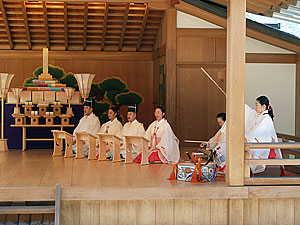
By Bill Roberts
Onisaburo Deguchi, Co-Founder of Oomoto, believed Japan is a microcosm of the world. In one of his odder ideas, spelled out in “Tales From the Spirit World,” he equates each of Japan’s major islands to one of the continents.
Honshu, the main island, is Eurasia. Kyushu is Africa. Shikoku is Australia. Taiwan (which was once part of Japan) is South America. And Hokkaido is North America. (Antarctica did not fit his model.) He even declared that Ayabe, Oomoto’s spiritual headquarters, is Jerusalem and Ayabe’s Wachi River is the Jordan River. Present Oomoto members can carry this Japan-centric idea to an extreme –the Inland Sea is the Mediterranean, for example. You can stop them at their own game, however, by asking where is Japan’s Sahara Desert.
I admit my skepticism to this idea. Yet I was forced to reconsider it during my visit to Hokkaido in late November with Hiromi Yano, my interpreter. Hokkaido is the northernmost island; the second largest and the least populated, with five million people sprawled across an area the size of South Carolina. Its physical traits couldn’t be more different from the narrow valleys, rounded hills and tightly packed civilization of the Kyoto area. Parts of Hokkaido are as wide open as Kansas or Iowa. Elsewhere jagged mountains rise like the Rockies. Portions of its seacoast could be Oregon. Maybe Onisaburo Deguchi was right. Maybe Hokkaido is a microcosm of North America.
What really made me reconsider his idea are the people of Hokkaido. I find people throughout Japan to be friendly, courteous and hospitable but usually with some reserve. In Hokkaido, they seem as wide open as the space they live in, with a backslapping, come-on-in-and-stay-awhile attitude that is very American. And like some Americans, some people in Hokkaido also are receptive to new, even wacky ideas. Here, then, are a few snapshots of the places and faces of Hokkaido.
From Sea to Shining Sea
As we land at the Sapporo airport, which is 35 miles away in Chitose, I can already see Hokkaido is different from Honshu. The landscape is flat, brown and bleak, much the way I remember the area around the Detroit airport (which is 35 miles from Detroit) at this time of year. Sapporo itself, with wide boulevards, large green spaces and modern buildings, sprawls across a wide plain. Just 15 minutes from the city center, mountains rise like they do near Salt Lake City and Denver.
The landscape changes as we take the train north into the interior. We cross a flat plain of fertile farmland –the soil almost black. It reminds me of Iowa and other parts of the Midwest. We climb gradually then are suddenly in broken terrain surrounded by forests, following a river. This land feels like western Pennsylvania or eastern Ohio. It becomes increasingly hilly and eventually we can see high mountains.
Hokkaido’s highest peaks are only 6,000 feet (half the height of the Rockies) but they rise from near sea level, giving the impression of being much higher. In the interior, where we stay in the hamlet of Yamabe (ya-ma-bay) for three nights, the peaks are snow covered and look somewhat like the area around Aspen, Colorado.
Yamabe, Oomoto’s Hokkaido headquarters, is 25 miles south of Furano. The main town in the area, Furano has 40,000 people and has hosted World Cup Skiing. It sits on a broad flat plain on the Sorachi River in the shadow of Mt. Ashiwake. The mountains are frocked in snow when we arrive but the plain is snow free and unseasonably warm. Two days later we depart in a hard-driving snow.
East and north of Furano is Daisetsuzan, Japan’s largest national park, home of Mt. Asahi, which at more than 6,000 feet is the island’s largest peak. With all its geothermal activity, Daisetsuzan could be Yellowstone National Park. Inside Daisetsuzan is an area called Tenninkyo with many waterfalls. One is Hagoromo, a series of three cascades that plunge down cliffs about 500 feet high. Hagoromo, which is also the name of a famous Noh drama, translates as “robe of feathers” or “angel’s robe.”
Hagoromo does not compare to Yellowstone Falls or Yosemite Falls but I’m sure somewhere in the U.S. there is a waterfall that resembles it. Other comparisons to North America are easier to make. The town of Otaru, a one-time fishing center on the Sea of Japan west of Sapporo, is a bit like Monterey, California. Lake Toya, in southern Hokkaido, is similar to Crater Lake in Oregon. But before I carry this to an extreme someone ask me where is Hokkaido’s Mojave Desert.
Twenty Hectares and a Ton of Daikons
Most American farmers I’ve met are generous, friendly men of strong religious faith. Kaname Igarashi, a farmer from north-central Hokkaido, is a lot like them. Igarashi and his family--wife, son and two daughters--traveled three hours by car from their farm to attend an Oomoto harvest service in Yamabe the last Sunday in November. The first thing worth noting about Igarashi is this: His wife and children drove the family minivan while he drove a panel truck full of daikons from his farm to give to people at the service.
At 20 hectares (about 45 acres) Igarashi’s farm is huge for Japan. Around Kyoto the average farm is less than an acre. Igarashi grows many crops including rice, wheat and beans. Nothing stirs his pride like his daikons. The daikon, a staple of the Japanese diet, is a member of the radish family, but nothing like our ping-pong ball sized red radishes. The daikon is white, carrot shaped and bigger. Much bigger in Igarashi’s case: His daikons are as big as piano legs.
The only thing bigger than Igarashi’s daikons is his heart. The Saturday before the harvest service we have a day to do what we want but no car. Igarashi offers to give us a tour. Under sunny skies and dappled clouds, we take off in his minivan.
Igarashi’s heart is in the right place, but he doesn’t know where he is going. We drive in circles, hitting dead-ends, missing turns. Igarashi finally gets his bearings and the day includes a trip to Hagoromo Falls, a visit to an onsen (hot springs spa), a lunch of soba (buckwheat noodles) and stops to try the local milk and cheese and to see a curious art gallery full of optical illusions.
Igarashi, 42, has been farming for 25 years and an Oomoto priest almost as long. His 17-year-old son, Hiromu, has already been a priest for five years. Father and son serve in the priest corps at the harvest service. One of the Igarashi girls plays in the koto ensemble.
Igarashi is an innovator. He is getting into organic farming, which he can discuss for hours. What concerns him most is that Japanese eat less rice now. Bad news for farmers, he says. When I tell him that I often eat rice three times a day in Japan, Igarashi breaks into a wide smile. Yano later tells me Igarashi liked me even better after he heard that.
I also tell Igarashi I like daikon. So he personally makes sure we have enough of it at dinner on Saturday. Just for me there are two plates of fresh sliced daikons piled as high as Mt. Ashiwake. It is a good thing we don’t have a car. He would have sent us home with daikons.
The Wild Bunch
I grew up in the 1960s in California, which was then a wellspring of innovation in education. Some ideas were downright radical. None were wilder than the Tomoe (toe-moe-ay) Kindergarten in the hills south of Sapporo.
Tomoe is housed in a tri-level building the size of two high school gymnasiums. The kindergarten, which has a staff of eight, 80 students and a lot of parental help, is a private “free” school. There is tuition. Free is a statement of philosophy.
Definition 2a of “free” in Webster’s New Collegiate Dictionary, is the operative one: “Not determined by anything beyond its own nature or being.” When we arrive on a Monday morning we see 80 children ages three to six doing basically whatever they please, not determined by anything outside themselves. Kids running, yelling, playing—a few trying to nap. Kids tumbling on mats, kicking soccer balls, sliding down slides, dancing, eating lunch (whatever they want), reading, playing board games, drawing, painting. Many moms and dads also participate.
The man behind this experiment is Kimura Hitoshi, who has a salt-and-pepper beard, a mop of hair and the stare of either madness or genius in his eyes, depending on your perspective. When we meet him, he is preoccupied with tossing and catching a child in the air, the kid laughing and pleading for more. After a few tosses, the kid leaps from Hitoshi’s arms to join the tumblers.
Hitoshi is 64 going on 50. His work keeps him very young. He was once a Mennonite minister (there are several Mennonite churches in Sapporo) but quit the church because he found it too confining. I don’t even bother to ask him if he’s a member of Oomoto and later I confirm my guess that he is not. He started Tomoe more than 20 years ago.
Hitoshi believes it is important for children to experience freedom and to develop a relationship with nature. The first two hours of each day are free play; the second two are more structured. Many activities are held outside. There are at least two field trips a month, including winter trips to the beach where the kids are encouraged to try the ocean even in sub-zero weather. Snow trips that include crawling on the belly through snowdrifts are also standard. In inclement weather there are play-days in the mud. These and tamer pursuits are documented in picture books he shows us. Hitoshi says his insurance is expensive, but he has not lost a kid or chaperone yet.
How do these children adjust to the rigid discipline they encounter when they start primary school? “They adjust better than other children,” Hitoshi says. “Because they have the confidence and experience this school gives them they can adapt to just about anything.” Students from years ago tell him Tomoe was one of the best things to happen to them.
Tomoe is a joy to behold at a time when we are horrified by press stories about Muslim schools in Pakistan, Afghanistan and Saudi Arabia that effectively brainwash boys. But the school is not universally appreciated. Hitoshi has tried to interest other educators but no one has adopted his ideas. He can’t even get the Japanese school board to certify Tomoe. He struggles financially. Only the most progressive parents even bother to show up for one of his recruitment presentations and one third of them say thanks but no thanks. About 10 percent pull their kids out after a few weeks.
A Suburban Minivan Mom
Hitoshi counts on people like Hitomi Magaki, a mother of four. Her two youngest children attend Tomoe and she is heavily involved with it. Mrs. Magaki is our chauffer, guide and hostess for two days in the Sapporo area. At first glance, she’s a Japanese version of the American suburban super mom. However, there’s even more to this 39-year-old woman who once worked in Oomoto’s Tokyo office.
Mrs. Magaki is a blast of energy with enough adrenalin for an army of super moms. Her husband is an architect. They have three boys: Ryo, 11, Kai, 10, and Raku, 6, and a daughter, Nadzuna, 3, who is the same extrovert her mother is.
They live in a small two-story house in west Sapporo. The first thing I notice on entering their home is a sumi ink painting that looks like the work of one of the Deguchis. Inside there are several more sumi paintings and calligraphy. I think: She’s lucky to have these pieces by Oomoto’s first family, the artistic Deguchi clan. Wrong.
Mrs. Magaki is an accomplished calligrapher and painter in her own right, who firmly believes in Oomoto’s teaching that art is a form of spiritual practice. She also does ceramics, plays the piano and studies koto. The calligraphy and sumi are first-rate, and she gives lessons in her home. Upstairs in the bedroom, more art: She has adorned the sliding doors to a closet with calligraphy. Stretching the entire length of one wall, in the space between the window and the ceiling, is a scroll of mountain scenes in various sumi styles. Her father works in wood as a hobby and with his help she carved the table and chairs in her family room. Besides raising four children and devoting time to art, she spends time at Tomoe and has a weekly radio show for women. In her spare time in the winter she skis and ice skates.
When we half-seriously suggest she start a school similar to Tomoe for Oomoto, she gives us a look that, in any culture, says, “Are you nuts?” She is a faithful, life-long Oomoto member and she knows its limitations.
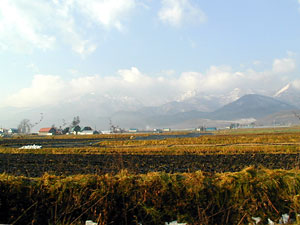 Farmland like Iowa and mountains like Colorado are two geographical similarities Hokkaido has to North America.
Farmland like Iowa and mountains like Colorado are two geographical similarities Hokkaido has to North America.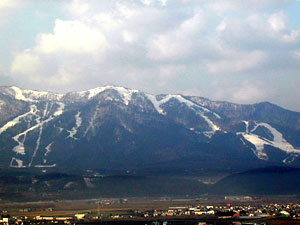 The mountains outside Furano are a world-class ski area.
The mountains outside Furano are a world-class ski area.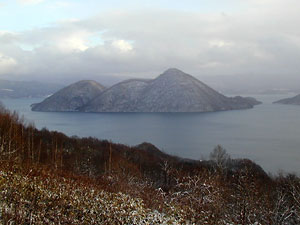 Lake Toya, south of Sapporo about 100 miles, resembles Crater Lake in Oregon.
Lake Toya, south of Sapporo about 100 miles, resembles Crater Lake in Oregon.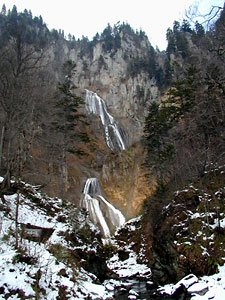 Hagoromo Falls is just one of many waterfalls in the Tenninkyo area.
Hagoromo Falls is just one of many waterfalls in the Tenninkyo area.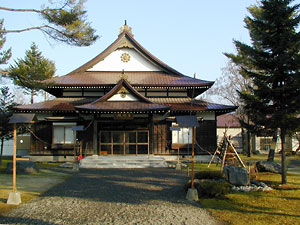 Oomoto’s Hokkaido headquarters in Yamabe.
Oomoto’s Hokkaido headquarters in Yamabe.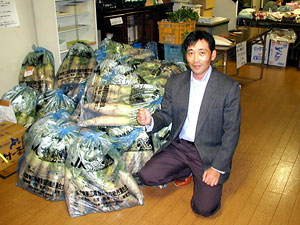 Farmer Kaname Igarashi with his pride and joy-- daikon radishes.
Farmer Kaname Igarashi with his pride and joy-- daikon radishes.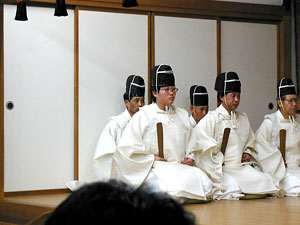 Father and son serve in the priest corps at an Oomoto Sunday service. Hiromu Igarashi, 17, is the young man in front with glasses. His father, Kaname, sits behind him.
Father and son serve in the priest corps at an Oomoto Sunday service. Hiromu Igarashi, 17, is the young man in front with glasses. His father, Kaname, sits behind him.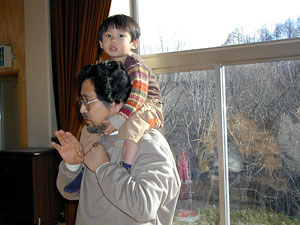 Kimura Hitoshi, founder of Tomoe Kindergarten in Sapporo, with one of his students.
Kimura Hitoshi, founder of Tomoe Kindergarten in Sapporo, with one of his students.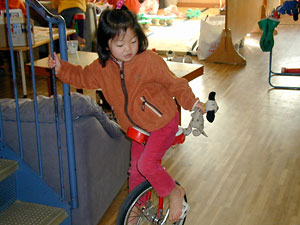 During free play, a Tomoe student tries out the unicycle.
During free play, a Tomoe student tries out the unicycle.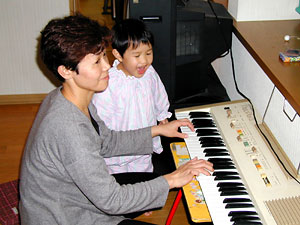 Hitomi Magaki and her daughter, Nadzuna, sing each night at bedtime in their Sapporo home.
Hitomi Magaki and her daughter, Nadzuna, sing each night at bedtime in their Sapporo home.New Contents Thu, May 20, 2010
- Oomoto participates in Sant’Egidio conference : Dialogue among religions and cultures : On divided island nation of Cyprus By Bill Roberts
- Photo Album : Portraits of three branches: Shoko, Tanegashima and Aomori By Bill Roberts
- Oomoto FAQ
- A Letter from Oomoto : Of mountains and myths By Bill Roberts
- Polyglot poem festival The Utamasturi is going international — what’s next? By Bill Roberts
- Ethics education program captures the spirit of Bankyo Dokon By Bill Roberts
- A Letter from Oomoto : A year’s worth of adventure in a summer of branch visits By Bill Roberts
- In Kumamoto, it’s all about water – and fire By Bill Roberts
- A speech by Nevada Taylor at the Kii Branch in Wakayama Prefecture on April 13, 2008.:An Encounter With Oomoto Through Aikido
- Utamatsuri, Poem Festival, in Tokyo(on April 17, 2008)
- A speech by Neil Ryan Walsh at the Kobe branch on Mar. 9th, 2008.:Planting the Seeds of the Soul
- Meeting with the Fifth Spiritual Leader of Oomoto, Madame Kurenai Deguchi by Neil Ryan Walsh
- A speech by Neil Ryan Walsh at the Nagoya branch on Feb. 17th, 2008.:The Japanese Arts beyond National Boundaries
- To the Oomoto branch in Nagoya: City of Eel and Toyota by Neil Ryan Walsh
- A Speech by Nissim Ben Shitrit, Ambassador of Israel on the occasion of the Oomoto Setsubun Grand Festival in Ayabe February 3rd, 2008 : Japan and Israel : Two Lands Balancing the Needs of Traditional Culture and Modern Life. r
- A permanent memorial to Onisaburo (A Speech at the Autumn Grand Festival , November 6, 2007 : )By James Parks Morton, Founder and Chair, Emeritus of The Interfaith Center of New York
- Israel, Palestine and the Power of Poetry(Oomoto believes small efforts can have lasting ripple effects on people and peace)By Bill Roberts
- “Something Great”(This genetics pioneer, a friend of Oomoto, offers a clue to the mystery of life)By Bill Roberts
- Kamishima Cleanup (Harima branch members regularly visit this sacred island to keep the shrine tidy)By Bill Roberts
- Kyotaro Deguchi was one of six recipients of the 2007 James Parks Morton Interfaith Award
What is Oomoto?
- What is Oomoto?
- Spirtual Centers
- Founders and Spiritual Leaders
- History
- Organization and activities
- Teachings and scriptures
- Art Works of Founders and Leaders
Opinions[Archive]
- Statement of regret for the outbreak of war against Iraq (March 20,2003)
- Jinrui Aizenkai dispatched the "Urgent Appeal for a World (Global) Crisis" on March 14.
Grappling with Bioethics[Archive]
- Oomoto’s support for abolishing the death penalty (12, June 2003)
- The Oomoto Foundation protests any birth of a human clone baby. (5, January 2003)
- OOMOTO'S VIEW REGARDING JAPAN’S PERMITION TO THE RESERCH OF HUMAN EMBRYONIC STEM CELLS (ES cells)(12, June 2000)
Vistor’s Review[Archive]
- A speech by Bill Roberts at the Oomoto branch in Hiroshima after its monthly service on March 18, 2007:Encounters with war and peace
- How Bankyo Dokon changed one life by Linda Macphee
- A speech by Bill Roberts at the Hokuriku (Kanazawa) branch on Dec. 3, 2006:Ritual and myth -an encounter with ‘divine madness’
- A speech by Bill Roberts at the Himeji Cultural Center on Feb. 25, 2007:Mesmerized by the Japanese Arts
- A speech by Bill Roberts at the Kobe branch on Feb. 11th, 2007.:There are just human tears and human joy
- A Speech on the occasion of the Oomoto Setsubun Grand Festival in Ayabe February 3rd, 2007 : Egypt's role in Middle East peace
- Keynote Speech for the 28th World Federation Japanese Religionists Conference for World Peace in Tokyo (at Kokugakuin University, Novermber 29, 2006):Vision for Peace in the Middle East By Dr. Munther S. Dajani, Professor Dean, Faculty of Arts, Al Quds University, Jerusalem
- A speech to the Kyoto branch:Spiritual adventures in researching Oomoto leaders
- A Speech at The Oomoto Foundation on Monday, November 6, 2006 : Jordan's role in Middle East By Samir Nouri, Ambassador of the Hashemite Kingdom of Jordan
- A letter from Oomoto:The Young People of Tottori
- A speech by Bill Roberts on the occasion of the dedication ceremony for the new shrine of Tottori Branch By Bill Roberts Oct. 8, 2006
- A speech by Bill Roberts at the Oomoto branch in Hiroshima after its monthly service on March 18, 2007:Encounters with war and peace
- How Bankyo Dokon changed one life by Linda Macphee
- A speech at Setsubun : A Portrait of Oomoto By Bill Roberts Feb. 3, 2006
- New Publication ! By Bill Roberts Feb. 3, 2006 A Portrait of Oomoto
you can read this book in html => http://www.jinruiaizenkai.jp/English/en-kolumno/en-bill/en-sugao/billbook1en.html
E-mail below to order brobert1@ix.netcom.com
Current Topics
- Prayer Offering and World Religious Forum II
- Living the art of dialogue
- Kyotaro Deguchi was one of six recipients of the 2007 James Parks Morton Interfaith Award
Books
Online Books
- Divine Signposts by Onisaburo DEGUCHI
- The Creation of Meaning by Hidemaru Deguchi
- Bankyo Dokon(Seventy years of Inter-Religious Activity at Oomoto)
- Nao Deguchi — A Biography of the Foundress of Oomoto
- The Great Onisaburo Deguchi published by Aiki News
- Bankyo Dokon Seventy Years of Inter-Religious Activity at Oomoto
- Insearch of Meaning
- Nao Deguchi A Biography of the Foundress of Oomoto
- A Portrait of Oomoto By Bill Roberts
Oomoto international Archive
- The History of Oomoto (Jan.– Mar. 1980 — Apr.– Jun. 1982)
- The Ancestors; Friends or Foes? (Apr.– Jun. 1987)
- Tsukinamisai; The Sabbath of Shinto (Jan.– Jun. 1983)
- The Poem Festival at Oomoto; An Ancient Rite Lives Again (Oct.– Dec. 1981)
- Purification of the Universe ; Oomoto's Setsubun Festival (Apr.– Jun. 1981)
Links
Flowers at Ten'on-kyo & Baisho-en (photographs)
Contact
All rights reserved : the Oomoto Foundation Produced by the Netinformational Commission
Since : Mar. 7.1998 Last Update : Thu, May 20, 2010
E-mail : webmaster@oomoto.or.jp
Top Page Nihongo Esperanto Português Roomazi



